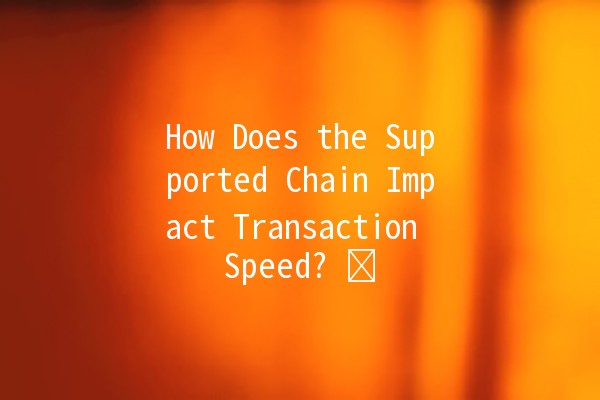




In the fastevolving world of blockchain and cryptocurrency, transaction speed has become a critical aspect for users, developers, and investors alike. As technology advances, the underlying framework of blockchain networks faces significant challenges and innovations. One question that often arises in discussions about transaction efficiency is, "How does the supported chain impact transaction speed?" In this article, we’ll delve deep into the intricacies of supported chains, network architecture, and the relationship with transaction speeds, offering practical advice and actionable tips to enhance your understanding of this complex topic.
A supported chain refers to the underlying blockchain architecture that a specific decentralized application (DApp) or smart contract operates on. These chains can vary in terms of their consensus mechanisms, transaction formats, and overall design, which can significantly influence transaction speed. Examples of popular blockchain chains include Ethereum, Binance Smart Chain, Polkadot, and Solana, each with its unique features and capabilities.

Selecting the appropriate supported chain for your DApp is foundational in influencing transaction speeds. Consider chains that provide faster consensus mechanisms and higher TPS. For example, Solana boasts impressive TPS rates, with the capacity to handle thousands of transactions per second. Evaluate your project’s needs, potential volume, and typical user behavior when making this choice.
Crafting optimized smart contracts is vital for enhancing transaction speed. Smart contracts that are wellcoded can execute transactions more efficiently. Techniques such as minimizing complexity and reducing unnecessary operations help smart contracts perform faster. Always test your contracts for efficiency and consider auditing from reputed sources.
Integrating Layer2 scaling solutions can dramatically improve transaction speeds while reducing costs. Solutions like Polygon and Optimism allow transactions to be processed offchain and subsequently resolved on the main chain. Implementing these technologies can significantly accelerate your project’s responsiveness without sacrificing security.
For networks like Ethereum that use gas fees, realtime analysis of network congestion can inform your gas fee strategy. Employ tools that allow for dynamic gas bidding, adjusting fees based on network activity. This approach can ensure that transactions are processed promptly during periods of high demand.
Utilize monitoring tools to analyze user behavior on your DApp. Understanding peak transaction times and user patterns can help you anticipate demand fluctuations. By aligning your operational strategies with these patterns, you can proactively manage speeds and enhance user experience.
The average transaction speed varies by blockchain. For instance, Ethereum typically processes transactions within 15 seconds, while Solana can achieve speeds under one second. It’s essential to align your expectations based on the network chosen for your project.
Network congestion occurs when the number of transactions exceeds the network’s processing capacity. During such times, users may experience delays as transactions are queued for processing, leading to potential frustration and decreased user satisfaction.
While Layer2 solutions significantly enhance transaction speeds, they are not a onesizefitsall solution. Depending on the implementation, they may introduce minor latency when finalizing transactions on the main chain. Nevertheless, they remain one of the most effective methods for addressing speed concerns.
Not all supported chains utilize gas fees. While Ethereum and some others do, many newer blockchain networks operate on different models that may not require direct fees or may incorporate them in more innovative ways. Always evaluate the fee structure of the chain you intend to use.
Transaction speed improvements can often be achieved postdeployment through optimization strategies, smart contract adjustments, and integrating additional technologies. However, significant changes may require redeployment or updates to the existing contract.
Realworld applications often adopt a multifaceted approach to handle transaction speed issues, including ongoing optimization, user education on transaction timings (e.g., advising on optimal times to transact), and sometimes launching their solutions atop faster networks or using hybrid models combining several chains.
To solidify your understanding, consider the following scenarios where the relationship between supported chains and transaction speeds comes into play:
DeFi Applications: Decentralized finance platforms require swift and secure transactions to facilitate lending, borrowing, and trading. For such applications, employing networks like Polygon and Avalanche can provide the necessary speed and efficiency.
Gaming DApps: Online games that utilize blockchain often experience high transaction volumes, especially during peak playtimes. Games built on faster chains can ensure seamless experiences without frustrating lag times.
Supply Chain Management: In sectors like supply chain management, where realtime tracking is critical, using supported chains with rapid transaction speeds ensures that all parties receive timely updates without delays.
By understanding the supported chains and how they impact transaction speeds, developers, users, and investors can make informed decisions that enhance operational efficiency and improve user experiences. Embracing the right technologies and strategies can lead to optimized transactions that meet the demands of an increasingly fastpaced digital economy.